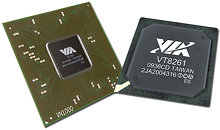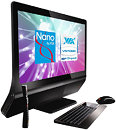- Joined
- Oct 9, 2007
- Messages
- 47,677 (7.43/day)
- Location
- Dublin, Ireland
| System Name | RBMK-1000 |
|---|---|
| Processor | AMD Ryzen 7 5700G |
| Motherboard | Gigabyte B550 AORUS Elite V2 |
| Cooling | DeepCool Gammax L240 V2 |
| Memory | 2x 16GB DDR4-3200 |
| Video Card(s) | Galax RTX 4070 Ti EX |
| Storage | Samsung 990 1TB |
| Display(s) | BenQ 1440p 60 Hz 27-inch |
| Case | Corsair Carbide 100R |
| Audio Device(s) | ASUS SupremeFX S1220A |
| Power Supply | Cooler Master MWE Gold 650W |
| Mouse | ASUS ROG Strix Impact |
| Keyboard | Gamdias Hermes E2 |
| Software | Windows 11 Pro |
VIA Technologies, Inc, a leading innovator of power efficient x86 processor platforms, today announced the VIA VN1000 digital media chipset for next generation desktop and all-in-one PCs, offering a world-class HD multimedia entertainment platform compatible with the advanced desktop features of Microsoft Windows 7.
The VIA VN1000 is the most power efficient DX10.1 digital media chipset available today, making it the perfect solution for next generation small form factor and all-in-one Windows 7 PCs that focus on entertainment, multimedia and touch screen capabilities. The DirectX 10.1 hardware environment provided by the VIA Chrome 520 IGP means Windows 7 users can enjoy a more fluid and visually enhanced desktop experience as well as the latest gaming titles.


The VIA VN1000 digital media chipset features the ChromotionHD 2.0 video processor to guarantee smooth playback of the latest Blu-ray titles with superb hardware acceleration of the most demanding H.264, WM9 and VC1 codecs over the latest display technologies, including Display Port and HDMI.
"The VIA VN1000 leverages our optimized VIA Nano 3000 Series processors, creating the most balanced, power-efficient, multimedia-focused desktop platform on the market today," said Richard Brown, VP International Marketing, VIA Technologies, Inc. "Supporting the latest system memory, graphics and entertainment standards, the VIA VN1000 takes the VIA processor platform to new heights of power-efficient visual sophistication."
At the core of the VIA VN1000 lies a DirectX 10.1 graphics engine, a necessary requirement for users who want to enjoy the enhanced features of the Windows 7 desktop environment. The DirectX 10.1 engine means that Windows 7 can employ Microsoft's advanced Windows Desktop Driver Model 1.1, bringing significant gains in system memory efficiency, overall desktop responsiveness and an improved visual experience compared to WDDM 1.0.
VIA VN1000 Product Highlights
Paired with the new VIA VT8261 south bridge, the VIA VN1000 represents the most power-efficient DX10.1 compliant digital media chipset on the market, consuming up to 12 watts for both north and south bridges, making it a perfect choice for Windows 7 based mini desktop and all-in-one desktop PCs designs.
Offering a feature-rich specification with significant emphasis on graphics and HD video playback, the VIA VN1000 features the VIA Chrome 520 IGP, combining a DirectX 10.1 graphics engine, with support for Shader Model 4, OpenGL 3.0 graphics and OpenCL 1.0 for next-generation GPGPU applications.
The high-performance ChromotionHD 2.0 video processor offers advanced filtering and cutting edge post-processing to perform ultra smooth decoding of MPEG-4/AVC, H.264, MPEG-2, VC-1, WMV-HD, and AVS video for Blu-ray content. The home theatre experience also encompasses support for the latest connectivity standards, including dual channel support for Display Port, HDMI, DVP, VGA and LVDS/TMDS.
The VIA VN1000 supports DDR3 system memory at speeds of up to 1066MHz, one x8 lane and four x1 lane PCI Express II expansion slots, up to five PCI slots and a VIA Vinyl HD 8 channel audio codec. An IDE controller, support for up to four S-ATA II drives, SD/MMS/MMC card reader support and 12 USB 2.0 ports are supplemented with support for PS/2, SPI, GPIO and LPC technologies.
The VIA VN1000 Digital Media IGP Chipset is fully compatible with all VIA Nano, VIA C7, VIA C7-M and VIA Eden processors and supports all Microsoft Windows platforms and popular Linux distributions.

View at TechPowerUp Main Site
The VIA VN1000 is the most power efficient DX10.1 digital media chipset available today, making it the perfect solution for next generation small form factor and all-in-one Windows 7 PCs that focus on entertainment, multimedia and touch screen capabilities. The DirectX 10.1 hardware environment provided by the VIA Chrome 520 IGP means Windows 7 users can enjoy a more fluid and visually enhanced desktop experience as well as the latest gaming titles.


The VIA VN1000 digital media chipset features the ChromotionHD 2.0 video processor to guarantee smooth playback of the latest Blu-ray titles with superb hardware acceleration of the most demanding H.264, WM9 and VC1 codecs over the latest display technologies, including Display Port and HDMI.
"The VIA VN1000 leverages our optimized VIA Nano 3000 Series processors, creating the most balanced, power-efficient, multimedia-focused desktop platform on the market today," said Richard Brown, VP International Marketing, VIA Technologies, Inc. "Supporting the latest system memory, graphics and entertainment standards, the VIA VN1000 takes the VIA processor platform to new heights of power-efficient visual sophistication."
At the core of the VIA VN1000 lies a DirectX 10.1 graphics engine, a necessary requirement for users who want to enjoy the enhanced features of the Windows 7 desktop environment. The DirectX 10.1 engine means that Windows 7 can employ Microsoft's advanced Windows Desktop Driver Model 1.1, bringing significant gains in system memory efficiency, overall desktop responsiveness and an improved visual experience compared to WDDM 1.0.
VIA VN1000 Product Highlights
Paired with the new VIA VT8261 south bridge, the VIA VN1000 represents the most power-efficient DX10.1 compliant digital media chipset on the market, consuming up to 12 watts for both north and south bridges, making it a perfect choice for Windows 7 based mini desktop and all-in-one desktop PCs designs.
Offering a feature-rich specification with significant emphasis on graphics and HD video playback, the VIA VN1000 features the VIA Chrome 520 IGP, combining a DirectX 10.1 graphics engine, with support for Shader Model 4, OpenGL 3.0 graphics and OpenCL 1.0 for next-generation GPGPU applications.
The high-performance ChromotionHD 2.0 video processor offers advanced filtering and cutting edge post-processing to perform ultra smooth decoding of MPEG-4/AVC, H.264, MPEG-2, VC-1, WMV-HD, and AVS video for Blu-ray content. The home theatre experience also encompasses support for the latest connectivity standards, including dual channel support for Display Port, HDMI, DVP, VGA and LVDS/TMDS.
The VIA VN1000 supports DDR3 system memory at speeds of up to 1066MHz, one x8 lane and four x1 lane PCI Express II expansion slots, up to five PCI slots and a VIA Vinyl HD 8 channel audio codec. An IDE controller, support for up to four S-ATA II drives, SD/MMS/MMC card reader support and 12 USB 2.0 ports are supplemented with support for PS/2, SPI, GPIO and LPC technologies.
The VIA VN1000 Digital Media IGP Chipset is fully compatible with all VIA Nano, VIA C7, VIA C7-M and VIA Eden processors and supports all Microsoft Windows platforms and popular Linux distributions.

View at TechPowerUp Main Site







